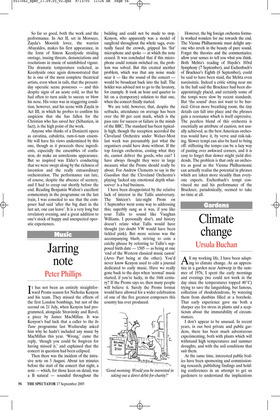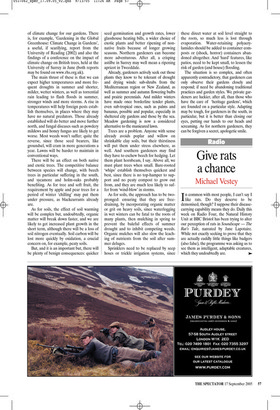Climate change
Ursula Buchan
All my working life, I have been adapting to climate change. As an apprentice in a garden near Antwerp in the summer of 1976, I spent the early mornings and evenings (we could not work in the day since the temperatures topped 40˚C) trying to save the languishing, but famous, collection of rhododendrons, by watering them from dustbins filled at a borehole. That early experience gave me both a sharper eye for stress in plants and a scepticism about the immutability of circumstances.
I don’t appear to be unusual. In recent years, in our best private and public gardens, there has been much adventurous experimenting, both with plants which will withstand high temperatures and summer droughts, and with the soil conditions that suit them.
At the same time, interested public bodies have been sponsoring and commissioning research, publishing findings and holding conferences in an attempt to get us gardeners to understand the implications of climate change for our gardens. There is, for example, ‘Gardening in the Global Greenhouse: Climate Change in Gardens’, a useful, if scarifying, report from the University of Reading (2002) and also the findings of a conference on the impact of climate change on British trees, held at the University of Surrey in June (both reports may be found on www.rhs.org.uk).
The main thrust of these is that we can expect higher temperatures and more frequent droughts in summer and shorter, milder, wetter winters, as well as torrential rain leading to flash floods in summer, stronger winds and more storms. A rise in temperatures will help foreign pests establish themselves, in places where they may have no natural predators. Those already established will do better and move further north, and fungal diseases such as powdery mildews and honey fungus are likely to get worse. Most weeds won’t suffer; quite the reverse, since those seed bearers, like groundsel, will cram in more generations a year. Lawns will be harder to maintain in conventional ways.
There will be an effect on both native and exotic trees. The competitive balance between species will change, with beech trees in particular suffering in the south, and sycamore and holm-oaks probably benefiting. As for tree and soft fruit, the requirement by apple and pear trees for a period of winter ‘chilling’ may put them under pressure, as blackcurrants already are.
As for soils, the effect of soil warming will be complex but, undoubtedly, organic matter will break down faster, and we are likely to get increased plant growth in the short term, although there will be a loss of soil nitrogen eventually. Soil carbon will be lost more quickly by oxidation, a crucial concern on, for example, peaty soils.
But, and it is an important but, there will be plenty of benign consequences: quicker seed germination and growth rates, lower glasshouse heating bills, a wider choice of exotic plants and better ripening of nonnative fruits because of longer growing seasons. Northern gardeners can become more adventurous. After all, a crisping astilbe in Surrey may well mean a ripening apricot in Tweeddale.
Already, gardeners actively seek out those plants they know to be tolerant of drought and drying winds: sub-shrubs from the Mediterranean region or New Zealand, as well as summer and autumn flowering bulbs and prairie perennials. And milder winters have made once borderline tender plants, even sub-tropical ones, such as palms and bananas, possible and popular, especially in sheltered city gardens and those by the sea. Meadow gardening is now a considered alternative to the manicured lawn.
Trees are a problem. Anyone with sense already avoids poplar and willow on shrinkable clay soils, but their thirstiness will put them under stress elsewhere, as well. And southern gardeners may find they have to eschew beech for hedging. Let them plant hornbeam, I say. Above all, we must plant trees when small. Bare-rooted ‘whips’ establish themselves quickest and best, since there is no top-hamper to support and no peaty compost to grow out from, and they are much less likely to suffer from ‘wind-blow’ in storms.
As for soils, the approach has to be twopronged: ensuring that they are freedraining, by incorporating organic matter or grit on heavy soils, since waterlogging in wet winters can be fatal to the roots of many plants, then mulching in spring to prevent the baleful effects of summer drought and to inhibit competing weeds. Organic mulches will also slow the leaching of nutrients from the soil after summer deluges.
Sprinklers need to be replaced by seep hoses or trickle irrigation systems, since these direct water at soil level straight to the roots, so much less is lost through evaporation. Water-retaining polyacrylamides should be added to container composts or (shock, horror) containers abandoned altogether. And ‘hard’ features, like patios, need to be kept small, to lessen the risk of garden (and house) flooding.
The situation is so complex, and often apparently contradictory, that gardeners can only observe their gardens closely and respond; if need be abandoning traditional practices and garden styles. We private gardeners are luckier, after all, than those who have the care of ‘heritage gardens’, which are founded on a particular style. Adapting may be tough, for gardeners in the south, in particular, but it is better than closing our eyes, putting our hands to our heads and screaming. As for northern gardeners, they can be forgiven a secret, apologetic smile.




















































 Previous page
Previous page